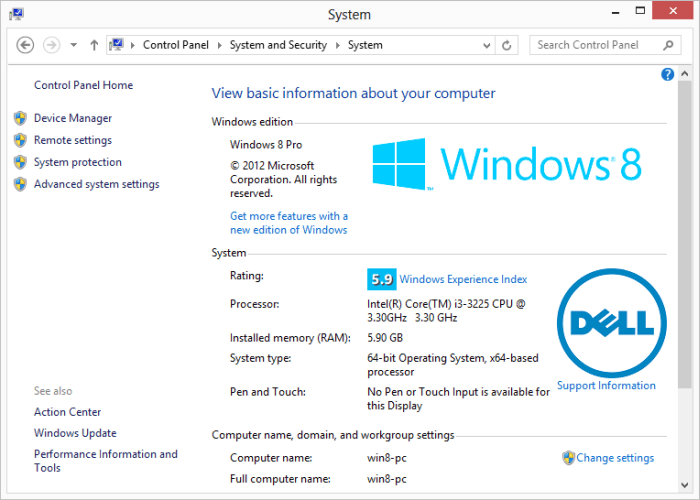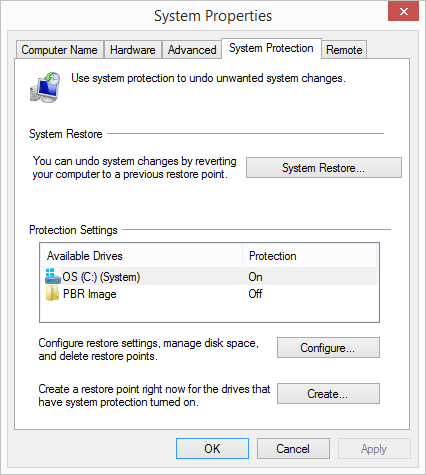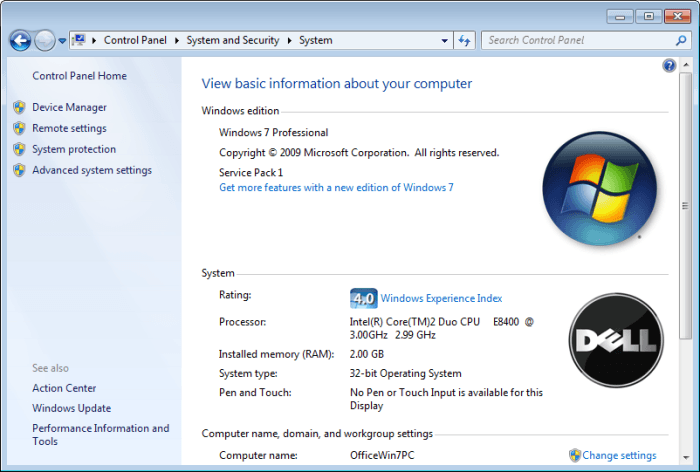Sometimes, installing software or device drivers has an adverse impact on your system. Setting a Restore Point prior to an installation allows you to reset your system to its previous state in case you discover that installing the new software wasn't such a good idea. (Restoring your system from a Restore Point is covered in the next tip.) Restore Points only deal with system files, so none of your personal data is affected.
To create a Restore Point, follow these steps if you are using Windows 8:
- Move the mouse pointer into the very bottom-left corner of the screen and right-click. You should see a Context menu appear.
- Choose the System option. Windows displays the System area of the Control Panel. (See Figure 1.)

Figure 1. The System dialog box.
- Click the System Protection link at the left of the dialog box. Windows displays the System Protection tab of the System Properties dialog box. (See Figure 2.)

Figure 2. The System Protection tab of the System Properties dialog box.
- Select the disk (under the Protection Settings group) for which you want to create a Restore Point
- Click the Create button. Windows displays the System Protection dialog box, prompting you to enter a description for the Restore Point.
- Enter a description of your choosing. (A good idea is to enter a reason for your restore point.
- Click Create. Windows creates the desired restore point.
If you are using Windows 7 the steps are a bit different. (The biggest difference is how you get to the first dialog box.). Follow these steps:
- Click Start, right-click Computer, and select Properties from the resulting Context menu. Windows displays the System area of the Control Panel. (See Figure 3.)

Figure 3. The System dialog box.
- Click the System Protection link at the left of the dialog box. Windows displays the System Protection tab of the System Properties dialog box. (See Figure 4.)

Figure 4. The System Protection tab of the System Properties dialog box.
- Select the disk (under the Protection Settings group) for which you want to create a Restore Point
- Click the Create button. Windows displays the System Protection dialog box, prompting you to enter a description for the Restore Point.
- Enter a description of your choosing. (A good idea is to enter a reason for your restore point.
- Click Create. Windows creates the desired restore point.

 This tip (12211) applies to Windows 7 and 8.
This tip (12211) applies to Windows 7 and 8.
Author Bio
Barry Dysert
Barry has been a computer professional for over 35 years, working in different positions such as technical team leader, project manager, and software developer. He is currently a software engineer with an emphasis on developing custom applications under Microsoft Windows. When not working with Windows or writing Tips, Barry is an amateur writer. His first non-fiction book is titled "A Chronological Commentary of Revelation." Learn more about Barry...
Ending a Frozen Program
Sometimes a program can get "stuck," meaning it is no longer responsive and appears to be doing nothing at all. You can ...
Discover More
Using Batch Files, Part 4: The CALL Statement
This tip is part of a series that talks about Windows batch files. It introduces a few more commands you can use in your ...
Discover More
Specifying a Copy Schedule in Robocopy
There are a few ways to set up a copy schedule in Robocopy by using its options. This tip explains how.
Discover More
Renaming with Emoticons
Looking for new ways to rename your files or folders within Windows 10? Emoticons can be used to provide whimsy or extra ...
Discover More
Understanding the Start Menu Search Box
The Start Menu Search Box is a great addition to Windows. It can save you a great deal of time by putting frequently used ...
Discover More
Understanding Virtual Memory
Computers can address far more locations than may exist in physical memory. The key to this feature is the use of virtual ...
Discover More




![]()
![]() This tip (12211) applies to Windows 7 and 8.
This tip (12211) applies to Windows 7 and 8.
Comments